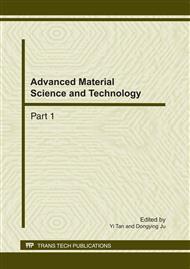p.1015
p.1019
p.1025
p.1031
p.1035
p.1041
p.1045
p.1049
p.1053
Application of Hydrophobic Silica/Fiber Composite Aerogels in Organic Absorption
Abstract:
SiO2 aerogels, the lightest solid material have attracted much attention recently. However, it is difficult to be used in practical applications due to its fragility. A facile one step polymerincorporation sol-gel process, together with a surface modification and a normal temperature drying process, was developed to prepare silica-fiber composite aerogels. Four fibers (polyester fiber, polypropylene fiber, lignin fiber, polycrylonitrile fiber) were selected to enhance the intensity of silica aerogels, respectively. The obtained samples were characterized by X-ray diffraction (XRD), Fourier transform infrared spectroscopy (FT-IR), Scanning electron microscopy (SEM), and Brunauer-Emmett-Teller (BET) specific surface area. Results showed that samples have a plenty of hydrophobic methyl group attached to their surface. The continuous network structure composed of silica aerogels of high purity are non-crystallized, porous, surface areas from 800 to 980 m2/g and light weight nano-materials. Adsorption experiment of the above samples over organic solution (benzene, toluene) was tested. The composite aerogels absorbed the organic liquids by nearly 6-8 times its own mass, showing potential application in organic absorption.
Info:
Periodical:
Pages:
1035-1039
Citation:
Online since:
February 2011
Authors:
Price:
Сopyright:
© 2011 Trans Tech Publications Ltd. All Rights Reserved
Share:
Citation:


